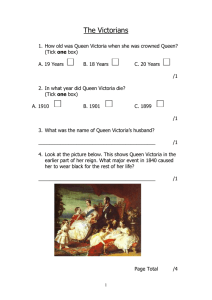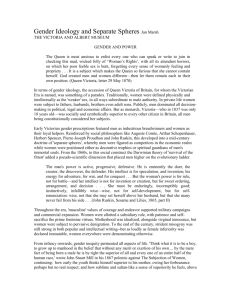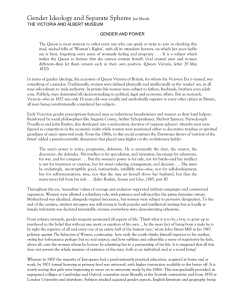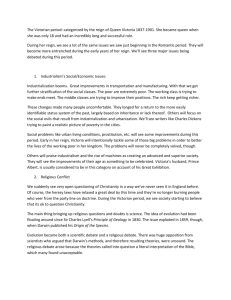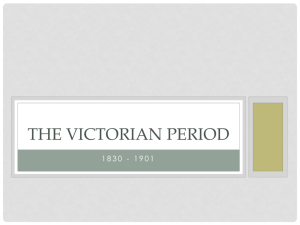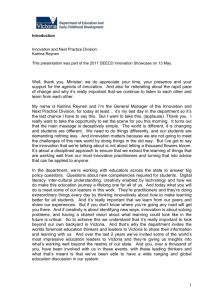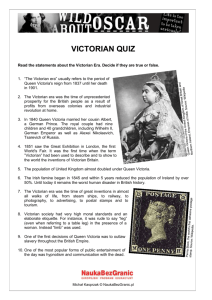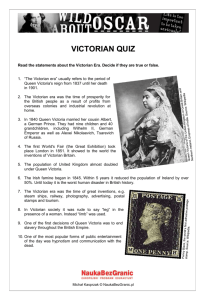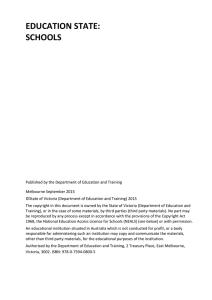The early Victorian Age (1832-1860) Although the 18-year
advertisement
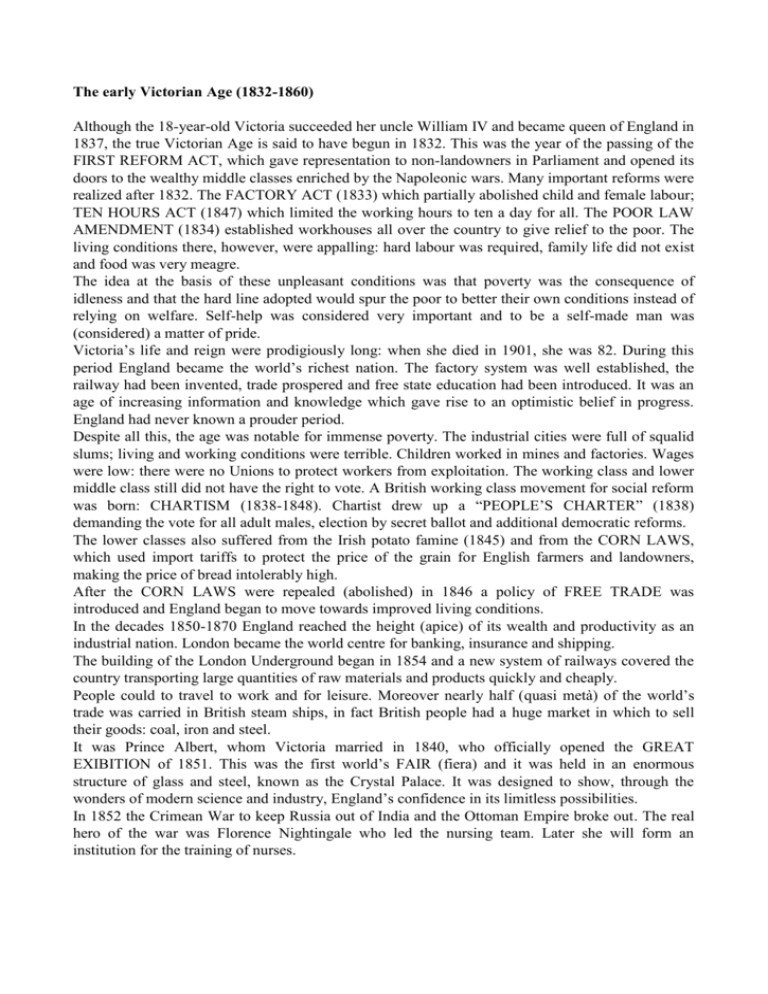
The early Victorian Age (1832-1860) Although the 18-year-old Victoria succeeded her uncle William IV and became queen of England in 1837, the true Victorian Age is said to have begun in 1832. This was the year of the passing of the FIRST REFORM ACT, which gave representation to non-landowners in Parliament and opened its doors to the wealthy middle classes enriched by the Napoleonic wars. Many important reforms were realized after 1832. The FACTORY ACT (1833) which partially abolished child and female labour; TEN HOURS ACT (1847) which limited the working hours to ten a day for all. The POOR LAW AMENDMENT (1834) established workhouses all over the country to give relief to the poor. The living conditions there, however, were appalling: hard labour was required, family life did not exist and food was very meagre. The idea at the basis of these unpleasant conditions was that poverty was the consequence of idleness and that the hard line adopted would spur the poor to better their own conditions instead of relying on welfare. Self-help was considered very important and to be a self-made man was (considered) a matter of pride. Victoria’s life and reign were prodigiously long: when she died in 1901, she was 82. During this period England became the world’s richest nation. The factory system was well established, the railway had been invented, trade prospered and free state education had been introduced. It was an age of increasing information and knowledge which gave rise to an optimistic belief in progress. England had never known a prouder period. Despite all this, the age was notable for immense poverty. The industrial cities were full of squalid slums; living and working conditions were terrible. Children worked in mines and factories. Wages were low: there were no Unions to protect workers from exploitation. The working class and lower middle class still did not have the right to vote. A British working class movement for social reform was born: CHARTISM (1838-1848). Chartist drew up a “PEOPLE’S CHARTER” (1838) demanding the vote for all adult males, election by secret ballot and additional democratic reforms. The lower classes also suffered from the Irish potato famine (1845) and from the CORN LAWS, which used import tariffs to protect the price of the grain for English farmers and landowners, making the price of bread intolerably high. After the CORN LAWS were repealed (abolished) in 1846 a policy of FREE TRADE was introduced and England began to move towards improved living conditions. In the decades 1850-1870 England reached the height (apice) of its wealth and productivity as an industrial nation. London became the world centre for banking, insurance and shipping. The building of the London Underground began in 1854 and a new system of railways covered the country transporting large quantities of raw materials and products quickly and cheaply. People could to travel to work and for leisure. Moreover nearly half (quasi metà) of the world’s trade was carried in British steam ships, in fact British people had a huge market in which to sell their goods: coal, iron and steel. It was Prince Albert, whom Victoria married in 1840, who officially opened the GREAT EXIBITION of 1851. This was the first world’s FAIR (fiera) and it was held in an enormous structure of glass and steel, known as the Crystal Palace. It was designed to show, through the wonders of modern science and industry, England’s confidence in its limitless possibilities. In 1852 the Crimean War to keep Russia out of India and the Ottoman Empire broke out. The real hero of the war was Florence Nightingale who led the nursing team. Later she will form an institution for the training of nurses. The late years of Queen Victoria’s reign (1860-1901) English political life was dominated by the struggle between the WHIGS and the TORIES or the LIBERALS and the CONSERVATIVES, as they were to be called. The Whigs represented the interests of the new wealthy middle class and were in favour of democratic reforms. The Tories were the party of traditional English values and institutions (Monarchy and the Church of England). Despite their differences both parties feared the demands of the radical representatives of the working class and realized that social reforms were necessary. Government was able to avoid revolution by COMPROMISE. After 20 years of uninterrupted Whig power, the period which goes from 1865 to 1893 passes through alternate periods of Conservative (Benjamin Disraeli) and Liberal (William Gladstone) rule. In 1867 Disraeli passed the SECOND REFORM ACT, which extended the vote to all members of the working class except agricultural labourers and miners. In 1870 the ELEMENTARY EDUCATION ACT recognized the need for general primary schooling; in 1872 the BALLOT ACT granted secret vote at elections. Trade Unions were legalized with the TRADE UNION ACT in 1871. Another problem of the time was Ireland. This island was very poor suffering famine from time to time. The large majority were Catholics. Many of them left Ireland for America to improve their condition. In 1870 an Irish leader, PARNELL, demanded “Home Rule”. Although Gladstone twice introduced an Irish Home Rule Bill, he never succeeded in getting approval in Parliament and was twice defeated by the Conservatives. Ireland didn’t achieve “Home Rule” until 1917 when the southern part of the island became an independent Republic. The six northern counties chose to remain in the UK, but with a degree of autonomy. In his second ministry (1880-1885) Gladstone passed the THIRD REFORM ACT (1884) which extended the vote to miners and agricultural labourers. In the last 30 years of Victoria’s reign the British Empire reached the height of its power and influence. English rule extended to Canada, Australia, New Zealand, India, South Africa and many other parts of the world. Queen Victoria was made Empress of India in 1877. British citizens were extremely proud of their Empire and of spreading their civilization to every corner of the globe. This attitude, a sort of racial superiority, was known as Jingoism. The Victorian Compromise (Values) The attitudes we regard (consider) as typically Victorian were those of the middle class: the new industrialists, merchants, professional men and property owners. Middle-class Victorians believed in: HARD WORK: they thought that material progress would emerge from hard work based on the SENSE OF DUTY. Great emphasis was placed on PUNCTUALITY and APPLICATION. SOCIAL RESPECTABILITY: a mixture of both morality and hypocrisy, severity and conformity to social standards. It implied a comfortable house with servants and a carriage, good manners, regular attendance at church and charitable activity. PHILANTHROPY addressed to every kind of poverty (stray children, fallen women, drunken men). The activists believed that they could save the dissolute and instil self-help. MORAL SERIOUSNESS: Victorians were conservative and often repressive in their attitudes towards worldly pleasures, private emotions and personal relationships. People still use the word “Victorian” as a synonym for “Prude” (esageratamente pudico) and think of the Victorian era as a time of extreme repression, when even furniture legs had to be concealed (hidden) under heavy cloth not to be too exciting. Sexuality was generally repressed in its public and private forms; words with sexual connotations were banned from everyday vocabulary. Middle class ideals also dominated VICTORIAN FAMILY LIFE. The virtuous example of Queen Victoria’s family life was imitated in the great houses of the bourgeoisie with a submissive mother, a patriarchal father and a huge number of children. Women however had a key role in child rearing (allevamento) and education. The problem of women’s rights became important at the turn of the century. The WOMEN’S SOCIAL AND POLITICAL UNION, whose adherents were the so-called “Suffragettes”, proved extremely active, but it was only in 1928 that women were given full voting rights.


